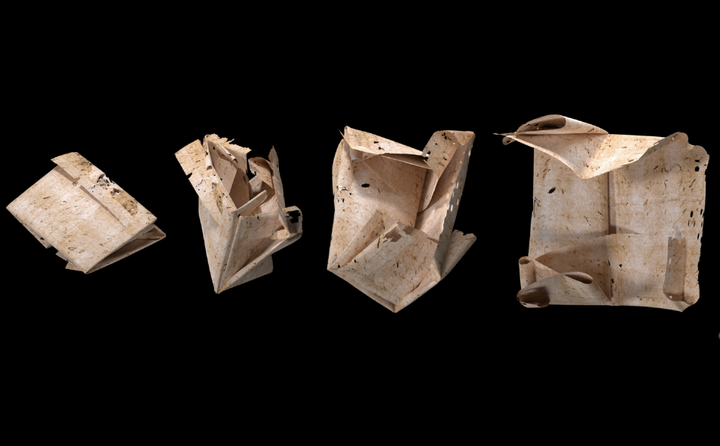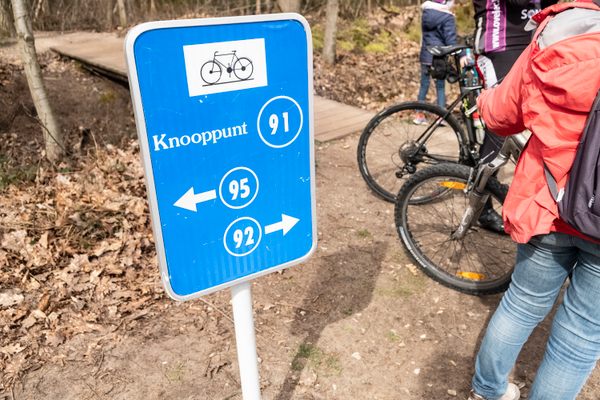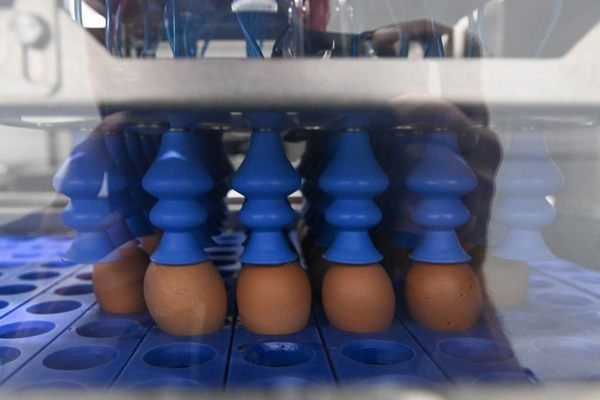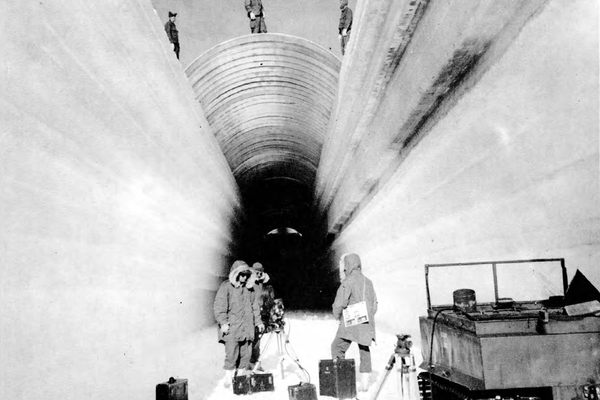
Cracking the Code of Letterlocking
A tale of Black Chambers, lost correspondence, and high technology.
If you sent a letter in 17th-century Europe, there was a good chance it would pass through one of the continent’s so-called “Black Chambers”—secret rooms attached to post offices and staffed by intelligence units, where mail was opened, copied, resealed, and sent on its way, with the writer and recipient none the wiser.
Nadine Akkerman, a senior lecturer at Leiden University, is an expert in 16th- and 17th-century espionage. But during her research into the Black Chambers, she ran across something perplexing—a document by Samuel Morland, a British spymaster, in which he bragged about his talent for opening and resealing letters. “Wait,” she thought to herself. “Can’t we all do that?”
It wasn’t until she met Jana Dambrogio and Daniel Starza Smith—researchers studying letters and document security during this period—that Morland’s braggadocio began to make sense. As it turns out, letters in the 1600s didn’t look exactly like letters today. Mass-produced envelopes weren’t invented until the 1830s, meaning that most 17th-century letter writers folded their correspondence in such a way that it became its own envelope—a process Dambrogio had dubbed “letterlocking.” Letterlocks could be simple, just a series of quick folds without any sort of adhesive. But they could also be incredibly complex, even booby-trapped to reveal evidence of tampering.

So when Morland referred to resealing letters, he meant replicating the complicated sequence of folds, tucks, and more that made up each particular letterlock. “Just imagine that you throw 1,000 origami birds on a pile and have to refold them quickly to make sure that the recipient doesn’t know that you’ve actually read that letter,” Akkerman says. “Of course, that is an art.”
Until recently, however, it was an art that had been mostly forgotten—due, in large part, to its ubiquity. Letterlocking was such a basic, unremarkable part of life that it was rarely documented or memorialized in writing. (Smith compares it to the act of locking your door today.) Dambrogio, now a conservator at the MIT Libraries, first noticed the telltale signs of letterlocking in 2000, during a fellowship at the Vatican Secret Archives. Since then, she’s spent the better part of two decades helping systematize and publicize the field. And the latest development from Dambrogio and her collaborators, a paper published recently in Nature Communications, would put the Black Chambers and Morland’s boasting to shame—they’ve developed a technique that allows locked letters to be read without opening them at all.
One of the major challenges of studying letterlocking is that physical evidence of the practice is so often erased. Most letters are, by nature, opened upon receipt. Many are then stored flat, further ironing out folds and tucks so that the only remaining proof of letterlocking might be slight discolorations or subtle cuts or creases visible only to a trained eye. And even if a letter managed to arrive at an archive unopened, standard practice held that it would be unsealed as soon as it was requested by a researcher. “Generally, when people wanted access to the words, that took precedence over the form,” Dambrogio recalls of her work across various archives. But she began to wonder: Could there be some way for researchers to get access to the content of a locked letter without also irrevocably losing evidence of its folding pattern?

This question became more pressing with the discovery of the Brienne Collection in 2014. Simon and Marie de Brienne, a husband-and-wife postmaster team in The Hague in the Netherlands, amassed a trove of dead letters over the course of their careers in the hopes that someone might eventually claim them—and finally pay postage. There are thousands of items in the Brienne trunk that show signs of letterlocking, but the real jackpot was 577 unopened letters sent between 1689 and 1706. From the very beginning, preservation was the goal. “Usually conservators come into a project in a different way, like we’re invited onto a team. This project’s really unique from that perspective,” Dambrogio notes, in that it’s “driven by conservation questions.” And letterlocking, in particular, is “this one niche of conservation where doing less is doing more.”
The answer to Dambrogio’s question about preserving both the content and form of each letter came from an unlikely source: an X-ray machine located in Queen Mary University of London’s dental school. Built by researchers David Mills and Graham Davis, it’s an extremely powerful imaging machine that can detect minute changes in the composition of a tooth or bone. The technique is in some ways comparable to a CT scan, if a CT scan could operate at the micron scale.

As Mills explains, this scanner was designed to determine precisely what materials make up an object—a sensitivity that was key for the letterlocking project because it sees more than shape. “If you only cared about the shape of the letters and being able to check the folds and tucks and the seals, you could go to a commercial system and get an answer in a tenth of the time,” Mills says. “If you actually want to see the ink on the page, you need us.” Most ink from the early modern period contained metal, particularly iron, which shows up as bright patches on the scan. With careful scanning, it can be used to recreate the text of the letter. The scans have also revealed watermarks, wormholes, and even bits of crushed eggshells or sand, which were often sprinkled on a freshly-written page to dry the ink. “We’re sometimes just surprised by how good the machines are,” Mills laughs.
Of course, extracting this level of detail takes time. The scanning process lasts three days, steadily translating the physical letterpacket into a massive brick of data. The next step is to run it through a complex series of algorithms, or a virtual unfolding “pipeline,” that can make the data legible.

Other researchers have tackled similar projects involving damaged parchment scrolls and documents that can’t be opened without destroying the contents, including several Dead Sea Scrolls and the charred Herculaneum papyri. But in these cases, the software had to be tailored specifically to a single artifact. “One of the really big challenges with this project is we had this one scan of 10 letter packets, but there are 600 more packets in this Brienne Collection that we’re interested in—and potentially thousands more in other archives around the world,” says Amanda Ghassaei, an independent researcher and coauthor of the study. “There are hundreds of different folding techniques. So we had to make something that was really general, that could handle any number of folds.”
“It wasn’t clear it was going to be possible,” coauthor Erik Demaine, a professor of computer science at MIT, noted in a press conference. “Often, the paper layers are so smashed together you can’t even see the air between the layers.” But when an early draft of the pipeline, built by Ghassaei and MIT undergraduate Holly Jackson, produced promising early results in 2016, they knew they’d more or less cracked the code.

In the end, the team was able to virtually unfold several sealed letters from the Brienne Collection—most notably, an exasperated dispatch by Jacques Sennacques, a French legal professional, to his cousin in the Netherlands, requesting that he send a specific notarized document as soon as possible. The pipeline also produced a clear diagram of the folding pattern he used, a fairly simple method that involved folding the letter vertically, then horizontally, to create a tight rectangular packet sealed by gluing down a flap.
“It blows my mind to think about what this person who wrote the letter that we transcribed would think, if you could explain to him what we’ve done,” says Ghassaei. “It’s kind of unbelievable.”
The other piece of the letterlocking puzzle—less technologically flashy but no less essential—is developing a shared language for the practice that can allow researchers to gather data on a much larger scale. To that end, the team has developed what Smith refers to as a “periodic table of letterlocking.” This took years of experimentation with letterlocking models, plus careful examination of a quarter-million locked letters in archives and libraries across the world. Eventually, their work yielded 12 formats—which describe the external shape of the letterpacket—and 64 categories, which describe the combination of folds, tucks, slits, holes, adhesives, and locking mechanisms used to create a particular letterlock.

Take locking mechanisms, for instance: Is the letter not locked at all? Locked by a completely different type of material, like a bit of string or wire? Locked with a piece of paper that’s been snipped off the corner of the letter itself? The most complicated and secure lock type—the one used by Mary, Queen of Scots, in her final letter—is an attached lock, a locking mechanism involving a strip of paper that’s only been partially severed from the original letter. The system also takes into consideration the possibility of a packet that involves a combination of some (or all) of these locks.
Only some of the categories have been matched with real-life historical examples, so far—many others are hypothetical styles that combine known attributes in possibly byzantine ways that may someday be discovered in other archives across the world.

Within the Brienne Collection itself, trends in letterlocking have already begun to emerge. Smith says he can see a clear distinction between the letters from the 1580s through 1620s that he’s studied, compared to the ones from the 1700s—a shift toward categories that more closely resemble the modern envelope. But this dataset is still limited to Europe during a fairly limited period of time. What will be revealed as these methods and metadata spread across the world? That’s the next big question for the letterlocking team—and why it’s taken so many years to publish this research, according to Dambrogio. “We could have published years ago, but we decided this is bigger than us. We want people to adopt the practice. So we need to invent this field so that people don’t shy away from it, so that they want to learn it, and so that the tools they have are accessible.” They’re in the process of publishing a book on letterlocking through MIT Press that will expand on their recent research.
“There are so many people working on letters, and there was no language before to talk about materiality in such a detailed way,” says Akkerman, also a coauthor on the paper. “It is very important that everyone speaks the same language.” There are already promising opportunities for further research: Ayako Letizia, a colleague of Dambrogio’s at MIT, is studying letterlocking techniques used by samurai in the 1500s. Another prime candidate for the virtual unlocking technique are the Prize Papers, a massive collection of undelivered mail seized from captured ships between the 17th and 19th centuries. “It’s really cool to be on a project where you spend 20 years, and it’s the starting point,” Dambrogio says. “That part, I think, is thrilling.”




















Follow us on Twitter to get the latest on the world's hidden wonders.
Like us on Facebook to get the latest on the world's hidden wonders.
Follow us on Twitter Like us on Facebook